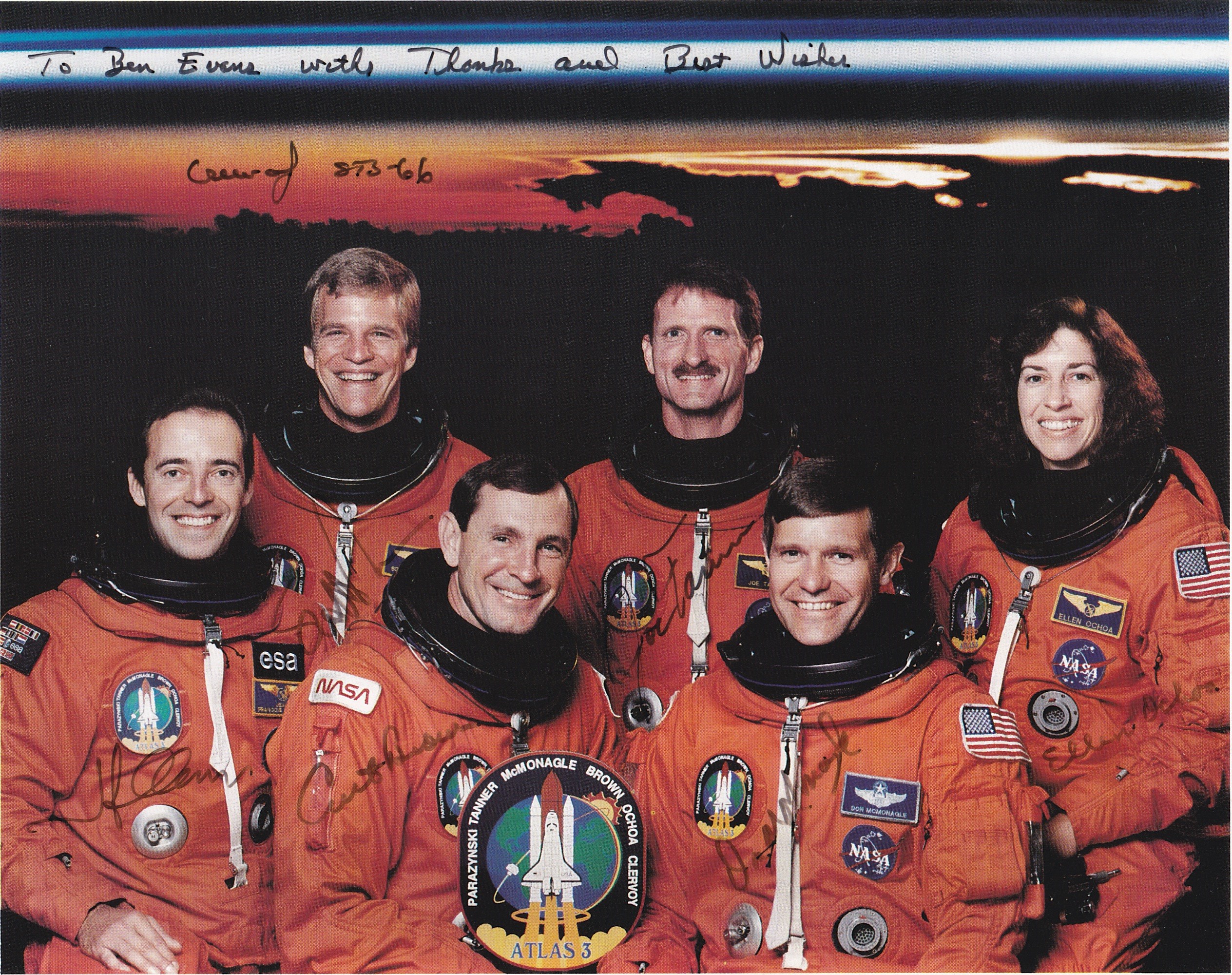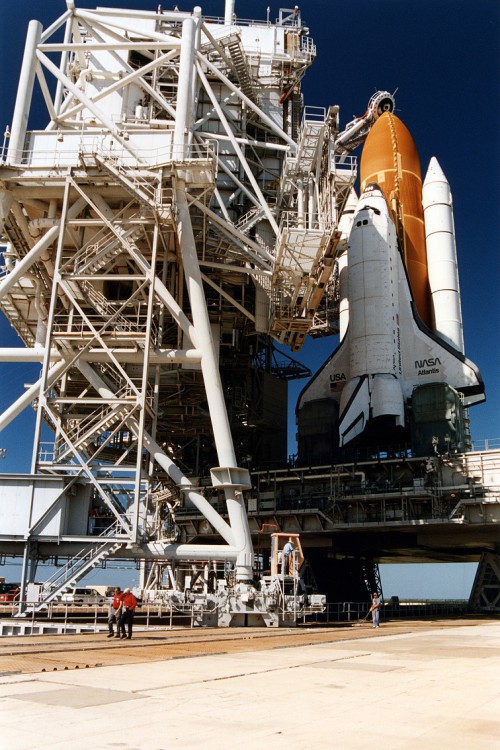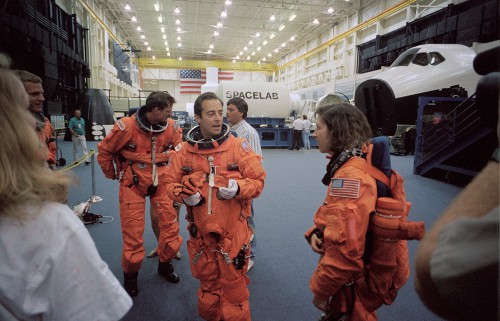
Twenty years ago, this week, the Space Station era began in earnest with the return to flight of Shuttle Atlantis, following a lengthy period of refurbishment. Since her STS-46 mission in July 1992, she had undergone many modifications to prepare her for voyages to Russia’s Mir space station and, eventually, the International Space Station (ISS). Her return to flight on STS-66 in November 1994 marked the culmination of a remarkable period, in which no fewer than three shuttle missions took place in a span of just eight weeks. First came the multi-faceted STS-64 in September—which featured the first untethered U.S. spacewalk in almost a full decade—and was quickly followed by the STS-68 radar-mapping expedition in late September and early October. With STS-66, which launched on 3 November 1994, NASA accomplished its best-yet record in the post-Challenger era for launching three back-to-back shuttle missions: a mere 55 days.
In fact, the three-flight, launch-to-launch record of 55 days, capped by STS-66, would never be surpassed throughout the remainder of the 30-year shuttle era. Only one occasion in the post-Challenger period—the three-mission salvo in October-December 1990, which delivered the Ulysses solar probe, a classified Department of Defense payload, and the ASTRO-1 astrophysics laboratory into orbit—came close, achieving 57 days from its first launch to its third. And even in the pre-Challenger epoch (which achieved a peak rate of nine shuttle voyages in 1985), only one trio of launches achieved better: just 54 days betwixt the flights of Missions 51J, 61A, and 61B from 3 October to 26 November 1985.
A seemingly minor record, perhaps, but STS-66 nonetheless topped a triumphant year for the shuttle program. At the dawn of 1994, NASA basked in the glory of the spectacular repair of the Hubble Space Telescope (HST) and executed seven successful missions, which put the reusable spacecraft’s myriad capabilities of rendezvous, spacewalking, and scientific research to the test. Two radar-mapping expeditions, the first Russian cosmonaut to fly aboard the shuttle and the orbiter’s longest-yet mission of almost 15 days produced an impressive tally, which, by year’s end, would see 41 spacefarers from four discrete sovereign nations—the United States, Russia, Japan, and France—spend a cumulative 81 days aloft. One of their number, Tom Jones, who flew aboard STS-59 and STS-68, would be alone among them in having flown twice during the same calendar year.

The 27-month period which elapsed between Atlantis’ STS-46 flight and her STS-66 mission was far longer than intended, partly due to the fact that she was extensively modified to accept the components necessary to rendezvous and dock with Mir. In fact, the intergovernmental agreements which oversaw the shuttle-Mir program were hammered out whilst she resided at Rockwell International’s facility in Palmdale, Calif. Atlantis was outfitted with improved nose-wheel steering, a tail-mounted drag chute, internal plumbing and electrical connections for the Extended Duration Orbiter (EDO) capability, and the first hardware elements for the Mir-compatible Orbiter Docking System (ODS).
STS-66 was originally scheduled for launch on 27 October 1994—which might have allowed her to snatch an all-time, three-flight, back-to-back record for the shuttle program of just 48 days—but it was not to be. NASA required additional time to refurbish three new main engines to replace those of Endeavour, whose STS-68 mission suffered a pad abort in mid-August, and engineers needed to replace a scratched flight deck window and tend to Atlantis’ plumbing system.
The primary payload for the mission was ATLAS-3, the third flight of the Atmospheric Laboratory for Applications and Science, and the final mission in a series which was originally supposed to fly annually throughout the Sun’s 11-year cycle of activity. As NASA and Russia drew closer and plans for a single shuttle-Mir docking mission crystallized into a series of nine or even 10 flights, between 1995 and 1998, several key shuttle payloads had to be dropped from consideration. These included a second Lidar In-Space Technology Experiment (LITE), Germany’s Spacelab-D3, a third Spacelab Life Sciences (SLS-3) mission, the pan-European Spacelab-E1, a reflight of the European Retrievable Carrier (EURECA) satellite … and at least two additional missions of ATLAS.
As late as January 1992, an ATLAS-4 flight was pencilled into the shuttle manifest for the end of 1995, joined by a deployable satellite equipped with an experiment to investigate waves in space plasma. However, by the April 1994 manifest, all such missions had vanished, replaced—for Atlantis, at least—by a series of back-to-back Mir-docking flights. Although shuttle-Mir would be critical to the success of today’s International Space Station, from an international-relationships perspective, it has been lamented over the years that a great deal of potential science was lost by deleting or defunding so many promising research missions from consideration.
It was clear when Ellen Ochoa, veteran of the ATLAS-2 mission, was named as the payload commander of STS-66 in August 1993 that ATLAS-3 would be the end of an era. Five months later, she was joined by her five crewmates: Don McMonagle in command, Curt Brown as pilot, and a trio of “rookie” mission specialists—Joe Tanner, Scott Parazynski, and Frenchman Jean-François Clervoy—all of whom would go on to carve their own niches in both the shuttle-Mir and ISS eras. With a substantial European involvement in the ATLAS-3 project (including the French-built SOLSPEC instrument), it was perhaps unsurprising that Clervoy was selected as a member of the crew.

Like the previous ATLAS missions, the crew of STS-66 was divided into two 12-hour shifts for orbital operations, with Don McMonagle leading the “red” team of Ochoa and Tanner and Curt Brown leading the “blue” team of Clervoy and Parazynski. The mission was slated to launch around noon EST, which offered “gentlemen’s hours” in terms of the 7:00 a.m. wake-up time for the red team … but, alas, the blue team were less fortunate. They would be bedding down for their first sleep shift a few hours into the STS-66 mission, and their pre-flight “sleep-shifting” pattern meant that—according to McMonagle in the post-flight press conference—they were awakened at 10:00 p.m. on 2 November, almost 14 hours before launch. Brown, Clervoy, and Parazynski would bed down for their first orbital sleep shift about three hours into the mission, after a 17-hour “day.”
Launch was delayed slightly, as the Mission Management Team (MMT) discussed wind speeds at one of the Transoceanic Abort Landing (TAL) sites. Weather conditions at Zaragoza and Moron, both in Spain, were initially acceptable, with Ben Guerir in Morocco classified as “marginal” for a time, in terms of crosswinds. Fortunately, the situation improved to an acceptable level by T-5 minutes, at which point Brown was instructed to activate the shuttle’s Auxiliary Power Units (APUs).
“Take Atlantis back to skies!” came the final goodwill call from the Launch Control Center.
“We’ll be happy to do that,” replied Don McMonagle from the commander’s seat. “We’ll see you in about 11 days.”
The second part of this article will appear tomorrow.
Want to keep up-to-date with all things space? Be sure to “Like” AmericaSpace on Facebook and follow us on Twitter: @AmericaSpace



